A hearty chicken potato stew in a rich Chinese-style sauce served on top of noodles. It’s one of those one-pot comfort recipes that you always crave.
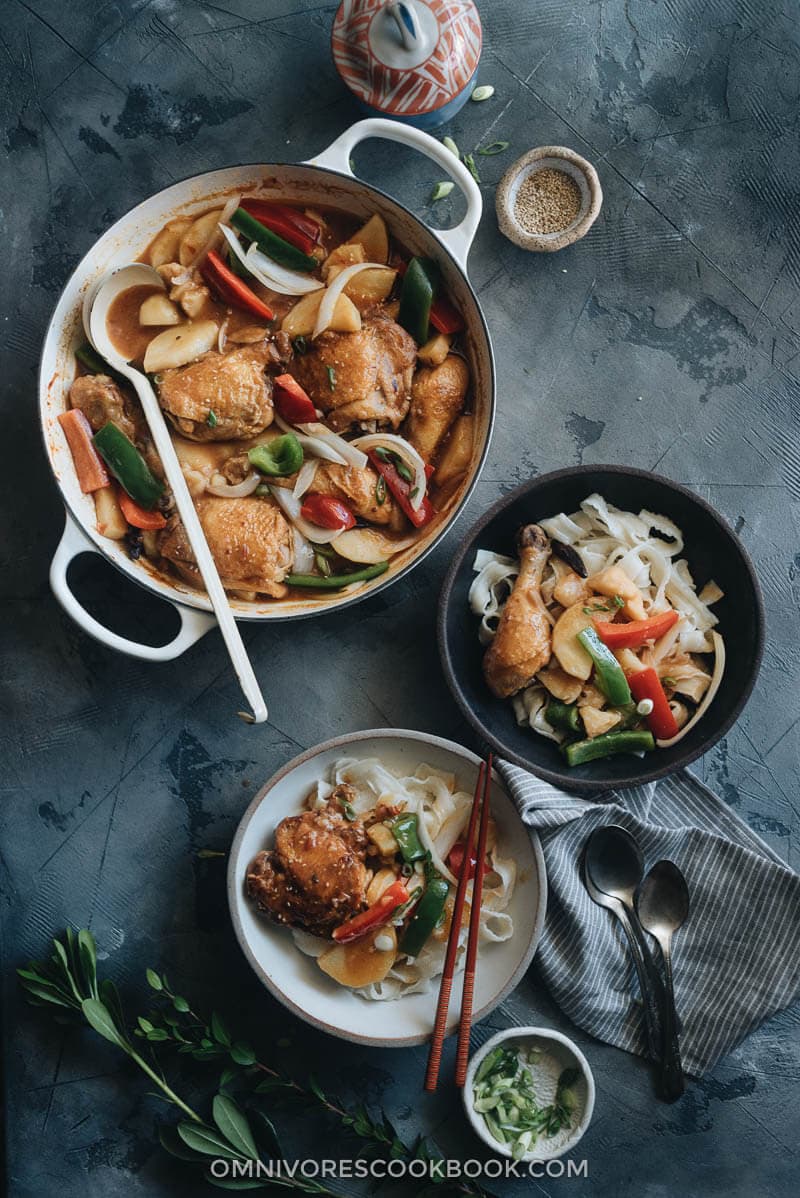
Da Pan Ji, which can be translated literally to “big plate chicken”, is a hearty chicken potato stew from Xinjiang Cuisine. It is one of those dishes that you might never have heard of outside of China, but will fall in love with the first time you try it.
Combining the flavor profiles of Middle Eastern cuisine and interior Chinese cuisine, the dish uses tons of garlic, ginger, star anise, chili peppers, cumin, fermented bean paste, and Sichuan peppercorns to create a super rich broth. The stew is loaded with chicken, potatoes, peppers, and onions. In Xinjiang restaurants, it is often served on hand-pulled noodles, and sometimes with naan, as well. It is a dish that many families cook at home. But it is so popular that it is a top dish for every Xinjiang restaurant.
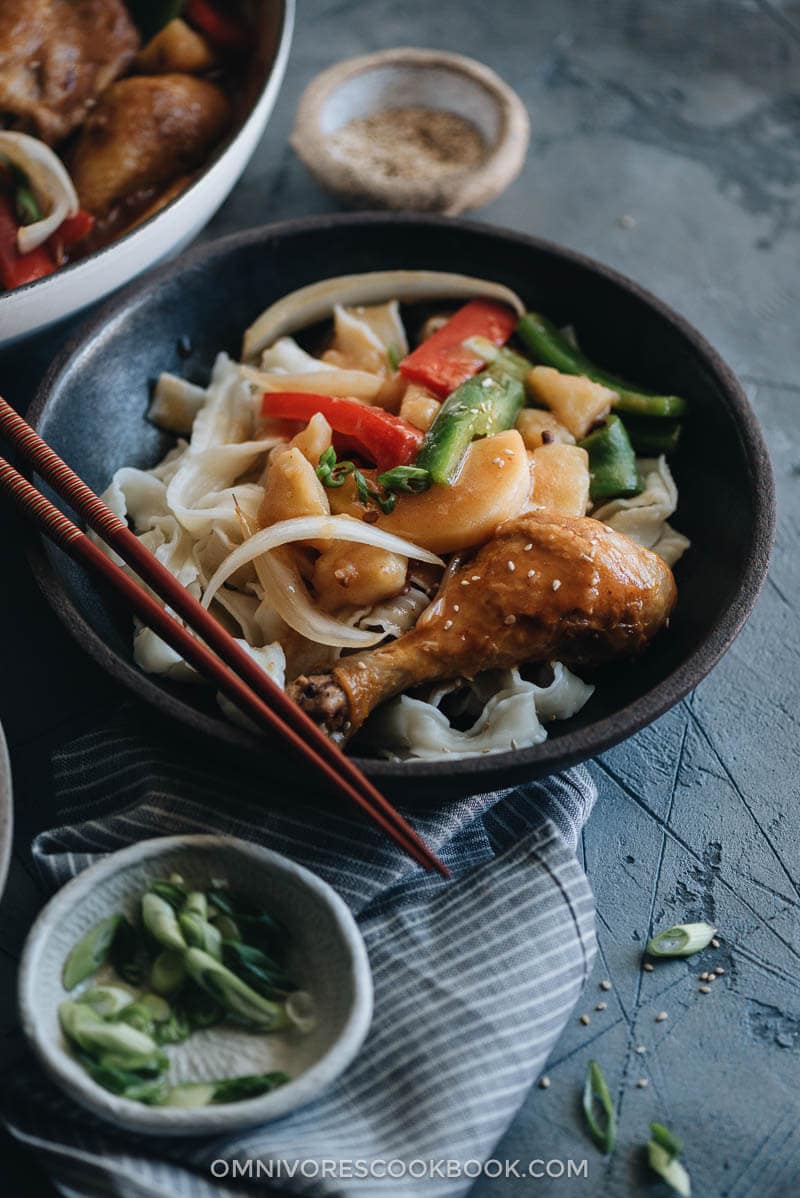
Cooking notes
It took me a while to decide how to approach this recipe, because I wanted to keep it as authentic as possible, but also more practical to make in a Western kitchen. Eventually I came up with a happy solution to make a modern Da Pan Ji without losing the original taste.
Cuts
To make the dish the authentic way, you should always use a whole chicken and chop it into bone-in bite-size pieces. The reason is that the bones will make the broth extra flavorful, and the meat will be seasoned well due to the small size.
Cooking in an American chicken, chopping up a whole chicken is my least favorite thing to put on a daily to-do list. It requires a heavy cleaver that I don’t have and it’s messy. However, I did want to use bone-in cuts instead of boneless ones.
In the end, I settled on bone-in thighs and legs. They are the next best thing to a chopped whole chicken. They are much easier to deal with and the result is just as good.
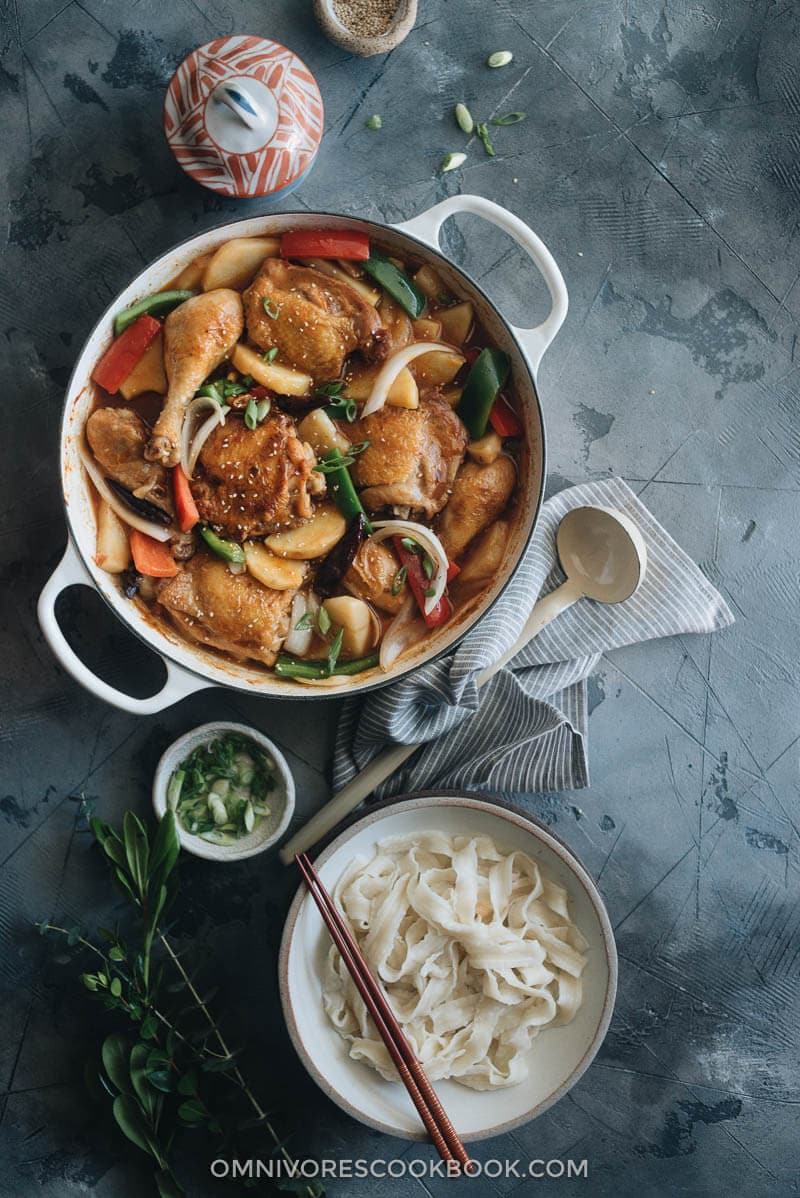
Cooking utensils
The original Da Pan Ji (and almost every Chinese meat stew, for that matter) is cooked in a wok. It’s a great way to braise meat because you can use less liquid to cover all the ingredients.
In this recipe, I decided to use my dutch oven to make this dish. There are two reasons I made the change:
- Because the larger cuts of chicken are easier to brown in a dutch oven than in a wok.
- I intentionally made more sauce for this recipe, so it would make the final noodle dish more scrumptious.
Serve
I love serving this dish with wide, thick noodles. If you live close to an Asian market, you can find them in the refrigerated section. You can also use other types of wide dried noodles such as udon noodles. If you’re feeling extra fancy, you can also serve the dish with hand pulled noodles.
One last word. Always make a full batch because it takes the same amount of time and you’ll always want to save some leftovers for later.

More Xinjiang recipes
If you give this recipe a try, let us know! Leave a comment, rate it (once you’ve tried it), and take a picture and tag it @omnivorescookbook on Instagram! I’d love to see what you come up with.

Da Pan Ji (Chicken Potato Stew with Noodles, 大盘鸡)
Ingredients
- 2 lbs (1 kg) bone-in chicken legs and thighs (*Footnote 1)
- Salt
- 1 tablespoon vegetable oil
- 1 tablespoon Sichuan peppercorns
- 1 thumb ginger , sliced
- 6 cloves garlic , smashed with a knife
- 6 Chinese chili peppers , dried
- 1 star anise
- 1 tablespoon doubanjiang Spicy Fermented Bean Paste
- 1 tablespoon cumin powder
- 2 tablespoons tomato paste
- 12 oz (330 ml) beer
- 2 cups chicken stock
- 2 tablespoons soy sauce
- 2 teaspoons sugar
- 2 (about 2 lbs/1 kg) russet potatoes , peeled and chopped
- 1/2 onion , chopped
- 2 bell peppers
- 4 tablespoons cornstarch (Optional)
- 24 oz (660 g) noodles , dried (preferably a thicker-style flat noodle)
Instructions
- Pat dry chicken with paper towel and sprinkle salt on both sides.
- Heat oil in a 4.5-quart dutch oven (or a deep skillet) over medium heat until hot. Add the chicken, skin side down. Cook until golden brown, 4 to 5 minutes. Turn to the other side and cook until golden brown. Transfer the chicken to a big plate.
- Your pan should have a lot of fat rendered from the chicken skin. Remove some fat using a few layers of paper towel held in a pair of tongs. If not (if using skinless chicken), add 1 tablespoon oil. Turn to medium low heat.
- Add the sichuan peppercorns. Cook until dark, scoop out with your spatula, and discard.
- Add ginger, garlic, dried chili peppers, and star anise. Stir a few times to release fragrance.
- Add the doubanjiang, cumin powder, and tomato paste. Stir and cook until the doubanjiang releases oil, 1 minute or so. Be careful not to burn the paste.
- Pour in the beer. Use your spatula to scrape the bottom to release the brown bits. Add back the chicken. Add the chicken stock, soy sauce, and sugar. Cook over medium heat until bringing to a boil. Turn to medium low heat. Cook covered for 20 minutes.
- Uncover, add the potato and the onion. Cook uncovered for 8 minutes. Cook for 15 minutes if you like softer potatoes.
- Add the bell peppers. Cook until the peppers turn tender, about 5 minutes. Taste the broth. It should be a bit salty by itself, if you’re planning to serve it over noodles. Add salt if needed.
- There are two ways to thicken the broth. Method 1: mix cornstarch with 1/3 cup water and stir to dissolve completely. Add half to the stew and stir. Continue adding the slurry and stirring until the broth turns thick enough to coat a spoon. Method 2: Remove the chicken from the pan. Use a spoon to smash some of the potatoes to release starch to thicken the broth.
- When the chicken stew is almost ready, bring a big pot of water to a boil. Cook the noodles according to the instructions.
- To serve, place noodles onto a plate, top with the stew as a sauce. Enjoy!
Notes
- If you don’t like chicken skin, you can use bone-in or boneless skinless thighs, as well. I recommend using a bone-in cut, so the sauce will be more flavorful.
- The nutrition facts below are calculated based on 1 of the 8 servings of the stew without the noodles.
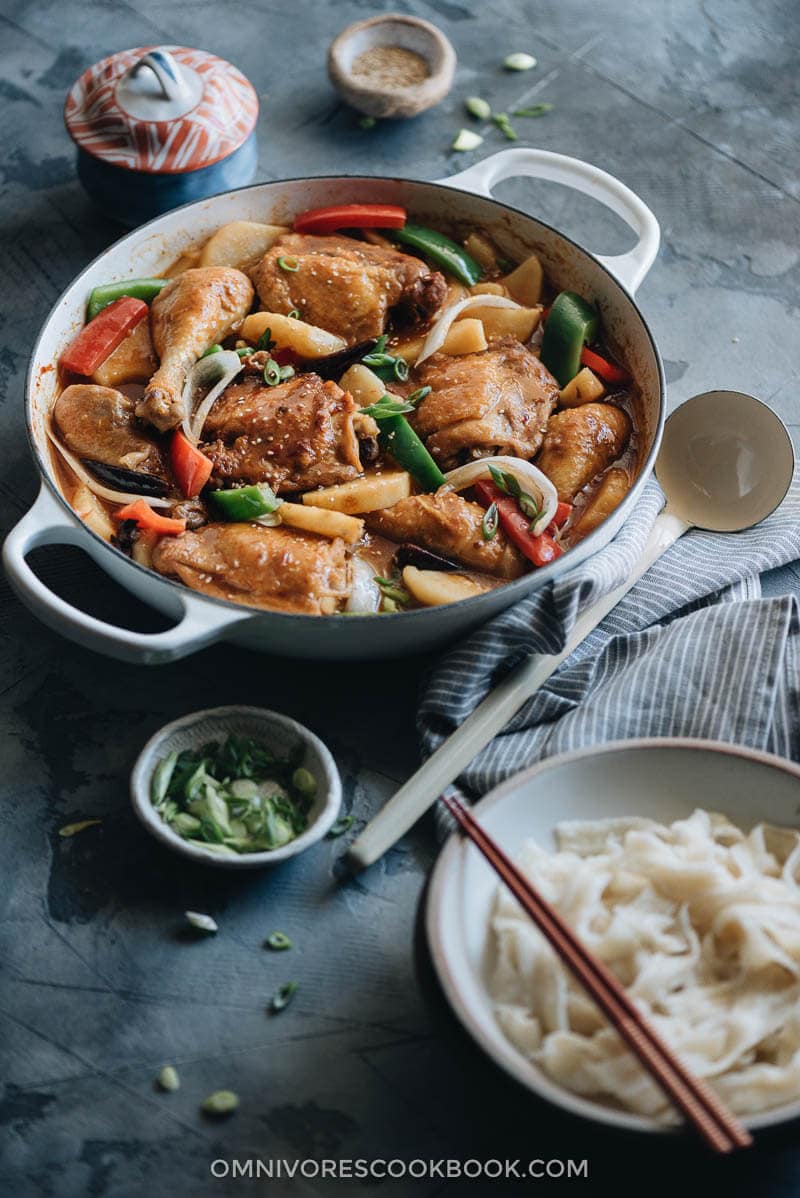
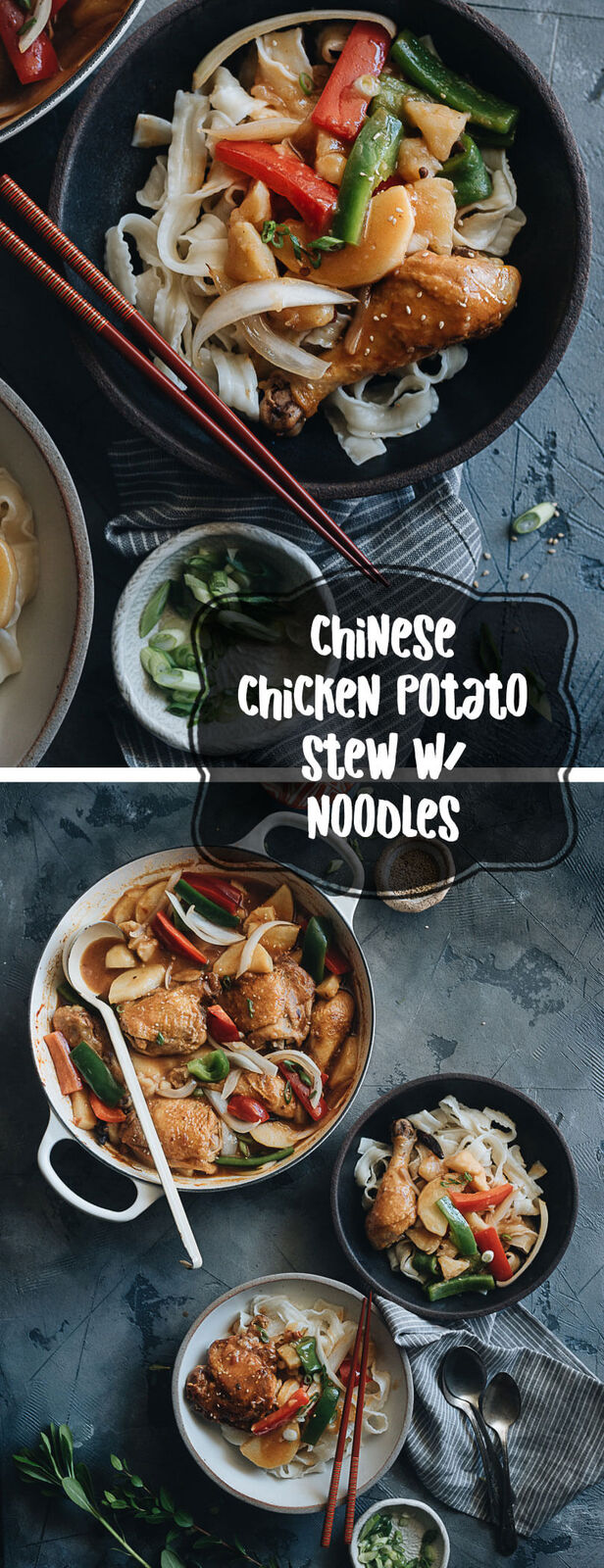













Maggie, this sounds amazing! I do hate cutting up a whole chicken though, so I’ll totally go the legs and thighs route. And I’m very excited to have a reason to go pick out some fresh noodles at the market! maybe someday I’ll try the hand pulled noodles 🙂 There’s this place I like to eat at that serves fresh hand pulled noodles and they are SO GOOD. One of my favs.
I have never heard of this “big plate chicken”, but dang it looks so amazing! I can see why this is served in so many Xinjiang restaurants. So many great flavors you added to this dish….incredible recipe
Do you recommend using a certain kind of beer?
Hey Maggie,
its great you’re shinning a light on Uighur cuisine! Im loving seeing more and more of it on english blogs. However, for this recipe in particular, I recommend to not ever use bell peppers, and only use long hot green Chinese peppers, and the use of beer is not needed. It is a Uighur recipe (who are Islamic) and using alcohol in cooking is just not a thing.
Caramelizing the chicken with the sugar and soy sauce is also really needed to get that rich colour, everything else is a great adaptation! Hope to see more Xingjiang recipes 🙂
OMG this is phenomenal. Tastes just like the real deal, thank you so much for the recipe! Look forward to exploring the rest of your site 🙂
So goood! Thank you so much for your contribution to and introduction in the real chinese kitchen…I have a ton of international cook books, but a real chinese one was not among them.
Maggie,
I’ve been following your recipes for time and I was really excited to see Xin Jiang cuisine because thats where my home town is. Dapanji is celebrated dish, and it is great for capturing the history of Xin Jiang, the dish was created by a Sichuan man who came to work in Urumqi, Xinjiang ( home to the ethnic indeginous peoples of chinas north west the Uyghurs) and was first sold at a Hui Zhou (Chinese muslim) restaurant. I think your dish looked beautiful i made it last night and it was very tasty, however it is not dapanji.
I understand that your dish was created for the sake of being accessible to different people. But by doing so i dont think it kept the qualities that make dapanji, dapanji. Even when I eat at Uyghur and Chinese restaurants in the states and Canada it always has the same components to it, as it did back home. Wherein, The chicken should be cut into smaller pieces, as dapanji literally translates to big plate chicken, it would not be dapanji without a dish of succulent pieces of chicken on the bone. traditionally the noodles are only used with the broth after wards. Im also sad to see the use of alchohol as because a majority of us are muslim in the north west, the original recipe never had alcohol, so much so that the annual dapanji festival in xinjiang discourages the use of alcohol so all the competing dapanji dishes will have a fair shot. also we dont use bell pepper, we use sichuan peppers and long green chinese peppers, and sugar and soy sauce are also used to give a sweet and spicy after taste and makes the broth of the chicken very thick- which takes us to the name “chicken potato stew”- although water and oil are used to create the broth the chicken should be cooked until it no longer is a stew but a minimal thick liquid coat (aided by the potatos) that coat your noodles after you finish the chicken. I also wanted to add that we dont use fermented beans either.
I hope you dont take my comment with malice, but this dish is very important to our people and it really celebrates the identity and unison of xinjiang and i hope you will consider making the dish in the tradition way to see how it tastes and if you life it! best wishes maggie,
Dia
What would be a good substitute for the beer? I never have it on hand at home.
Hi Kay, you could substitute the beer with 1 cup chicken broth plus 2 tablespoons Shaoxing wine (or dry sherry). If you don’t any alcohol at home, 1 cup chicken broth works too. Alcohol adds a nice tanginess to the dish but you can do without.
Wonderful home coking recipe. Thank you for this dish. I get many ideas/recipes from you to cook for my family. It brings me memories of my mother’s Chinese home cooking dishes.
I love your website. I’m a bit of an adventurous cooker and I get so bored of recipes. I don’t have much experience with Chinese cooking but I have lots of access to ingredients (similar at least) in Vietnam. I can’t wait to try them!
Hi Maggie :-> I love your recipes! The flavors in this one really interest me but I’m not a big fan of doubanjiang. Would this recipe still be tasty if omitted or would it not really come together? Is there a good sub for the strong flavor of the fermented beans, maybe mushrooms…? Thanks!!
I think if you have fermented beans (or the fermented bean sauce) that will be a great replacement 🙂